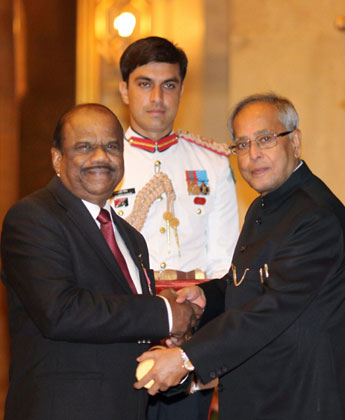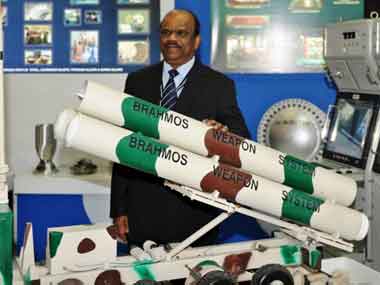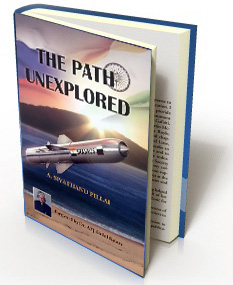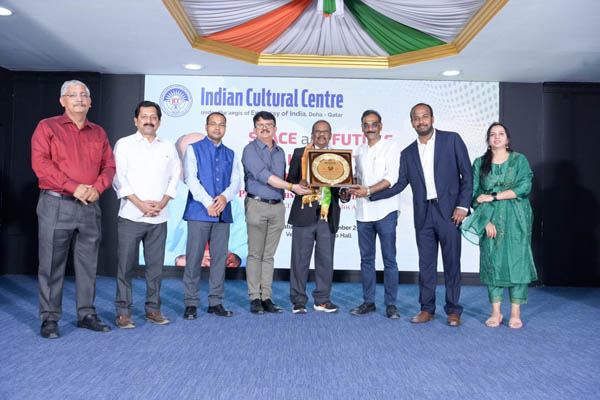5th Convocation Address
Association of Minimal Access Surgeons of India (AMASI), Coimbatore
21 July 2012
By
Dr. A. Sivathanu Pillai
Distinguished Scientist & Chief Controller R&D, DRDO & CEO&MD, BrahMos Aerospace
Honorary Fellow of the Association of Minimal Access Surgeons of India
Emerging Trends in Minimal Invasive Surgery
I am indeed delighted to participate in the 5th Convocation Ceremony of the Association of Minimal Access Surgeons of India. I thank Dr. Palanivelu for giving me the opportunity to share this moment of joy and celebration with Surgeons, Doctors and medical professionals assembled here. I congratulate those who received Fellowships today and wish them all success, my greetings to all of you.
Dr. Palanivelu is a renowned and exceptional Laparoscopic Surgeon and one of the few to be recognised by the whole world. He received recognitions such as B.C. Roy National Award from govt. of India and International Olympic Surgery Silver Medal for his exemplary contributions in Minimal Access Surgery. We are proud of Dr. Palanivelu whose innovative procedures have been accepted as standard practice in many countries. The establishment of ‘Gem Foundation & Charitable Trust’ and ‘Mobile Gastroenterology & Women Clinic’ are examples of his concern for the development of society.
A Certificate of Recognition by New York City Council was given to Dr. Palanivelu as a rare gesture for his contribution for creating awareness about lifestyle diseases and for being a pioneer in weight loss surgery in Asia.
Association of Minimal Access Surgeons of India (AMASI)
Association of Minimal Access Surgeons of India (AMASI), with an objective to provide education & training to surgeons in the field of Laparoscopic Surgery, was started in the year 2003 as a subsection of Association of Surgeons of India (ASI) under the guidance of the Founder President Dr. Palanivelu. Since then it has attained phenomenal growth with members joining from all over the country. AMASI now has over 4200 active members which is one of the largest Minimal Access Surgical Associations in the World. Thanks to his efforts, laparoscopy is now being performed as a routine procedure in many hospitals.
The skill courses conducted by this prestigious organization have become hallmark of the Association in terms of surgical education and maintaining standards. Besides organising skill courses, AMASI is also organising Zonal CMEs and workshops in different parts of the country with live demonstration of basic to advanced surgeries. The main thrust of the Association is to increase the penetration of laparoscopy in India. It is indeed making rapid strides towards its mission of "MAS (Minimal Access Surgery) for mass".
Advancements in Surgeries
For centuries, physicians have employed many simple non-invasive methods based on physical parameters in order to assess body function in health and disease. The discovery of the first modern non-invasive techniques based on physical methods, electrocardiography and X-rays, dates back to the end of the 19th century. Since then, non-invasive methods have continuously enlarged the scope of medical technology for diagnosis and therapy. Gone are the days where the surgeons performed the traditional type of open surgeries through long incisions made in the patients’ body. It did take considerable time to stay back in the hospital for post surgery care. The technology has influenced to a greater level in the medical field. Automated systems using robotic technology finds huge applications in the surgical procedures. The advent of communication and robotic technology led to the new concept of Tele-robotic surgery that saves the time and use of available expertise in any corner of the world. The first Transatlantic Robotic Gall bladder Surgery was successfully performed in the year 2001. The Doctor was in New York City and the patient was in France 6450 kilometers away. The surgery lasted for 54 minutes.
Laparoscopic surgery or keyhole surgery is a modern surgical technique in which operations are performed through small incisions as opposed to the larger incisions needed in the traditional surgeries. The advantages of this surgery are many. Minimally invasive surgery has less operative trauma for the patient than an equivalent invasive procedure. It causes less pain and scarring, speeds recovery, and reduces the incidence of post-surgical complications, such as adhesions.
The applications of minimally invasive medicine include mutiphoton tomography of human skin based on near infrared femtosecond laser excitation of endogenous biomolecules, use of “Camera Pill” novel disposable miniaturized imaging tool for colour imaging of the entire intestinal tract and stomach, minimally invasive examinations of the heart through heart catheter and refractive eye surgery with the application of novel ultrashort laser systems. The potential prospects would be multiphoton tomography in combination with other imaging technique to detect single cancer cells, development of novel endoscopes based on high resolution optical coherence tomography etc.
3D LAPROSCOPIC SURGERY
3D Laparoscopic surgery uses stereoscopic technical enhancements to traditional laparoscopes to allow depth perception. This has long been known to improve surgical performance. Autostereoscopic display has been shown to enhance task performance time even more than the gain with a binocular visor compared to classic 2D laparoscopy. Augmented reality techniques are also being developed that allow integration of the laparoscopic view field with imaging results.
TECHNOLOGY REVOLUTION
 During the last 5000 years, unique cultures have come into existence as the man continuously attempted to have a better life for himself and the society
around him. Particularly in the last 200 years, the society got transformed from purely agriculture to industrial, and then to information with different
manifestations. The Industrial Revolution in the eighteenth century paved the way for economical development making the life better with new opportunities
and a large scale employment. Information technology revolutionised man’s life further forming part of major economy. In addition to the industrially
developed countries, the economy grew faster in the developing countries also due to the information revolution. IT revolution taking the advantage of
large skilled human resource further added to the economic prosperity. Recent developments in bio and nanotechnologies and their convergence with
information technology opened up greater opportunities for the future.
During the last 5000 years, unique cultures have come into existence as the man continuously attempted to have a better life for himself and the society
around him. Particularly in the last 200 years, the society got transformed from purely agriculture to industrial, and then to information with different
manifestations. The Industrial Revolution in the eighteenth century paved the way for economical development making the life better with new opportunities
and a large scale employment. Information technology revolutionised man’s life further forming part of major economy. In addition to the industrially
developed countries, the economy grew faster in the developing countries also due to the information revolution. IT revolution taking the advantage of
large skilled human resource further added to the economic prosperity. Recent developments in bio and nanotechnologies and their convergence with
information technology opened up greater opportunities for the future.
CONVERGENCE OF TECHNOLOGY
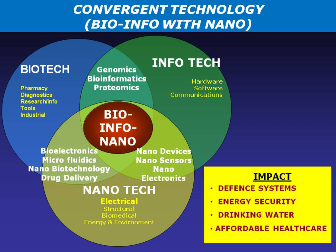 The information technology and communication technology have already converged leading to Information and Communication Technology (ICT). Information
Technology combined with biotechnology has led to bioinformatics. Similarly, Photonics is grown out from the labs to converge with classical Electronics
and Microelectronics to bring in new high speed options in consumer products. Flexible and unbreakable displays using thin layer of film on transparent
polymers have emerged as new symbols of entertainment and media tools. Nanotechnology is the field of the future that will replace microelectronics and
many fields with tremendous application potential in the areas of medicine, electronics and material science.
The information technology and communication technology have already converged leading to Information and Communication Technology (ICT). Information
Technology combined with biotechnology has led to bioinformatics. Similarly, Photonics is grown out from the labs to converge with classical Electronics
and Microelectronics to bring in new high speed options in consumer products. Flexible and unbreakable displays using thin layer of film on transparent
polymers have emerged as new symbols of entertainment and media tools. Nanotechnology is the field of the future that will replace microelectronics and
many fields with tremendous application potential in the areas of medicine, electronics and material science.
When Nano technology and ICT meet, integrated silicon electronics, photonics are born and it can be said that material convergence will happen. With
material convergence and biotechnology linked, a new science called Intelligent Bioscience will be born which would lead to a disease free and more
intelligent human habitat with longevity and high human capabilities. Convergence of bio-nano-info technologies can lead to the development of nano devices
like nano robots. When Nano robots are injected into a patient, it will diagnose and deliver the treatment exclusively in the affected area and then the
nanorobot gets digested as it is a DNA based product. Drug delivery system will revolutionize the healthcare to a large extent. Nanosensor based smart drug
delivery systems discharge drug in appropriate quantity and at right time. 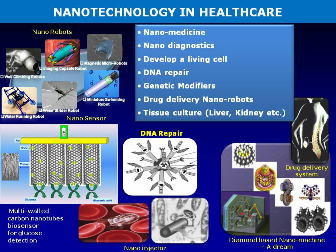 Nano Bio medical sensors will play a major role in glucose detection and
endoscopic implants. Immuno assays can be used for detecting antigens in blood samples by introduction of nanoshells attached to anti bodies while sampling
blood. Similarly, the nanotechnologies offer a wide range of opportunities such as synthetic scaffolding and nanoceramic coatings for tissue repair and
implants respectively. Dip pen nanolithography is a latest nanofabrication method which uses microscopic tips coated with a material which can be metals,
DNA, proteins that is deposited as ‘ink’ on a wide range of surfaces such as silicon, glass or metal. Convergence of technologies opens up new areas for
research and ultimately results in the betterment of the human beings.
Nano Bio medical sensors will play a major role in glucose detection and
endoscopic implants. Immuno assays can be used for detecting antigens in blood samples by introduction of nanoshells attached to anti bodies while sampling
blood. Similarly, the nanotechnologies offer a wide range of opportunities such as synthetic scaffolding and nanoceramic coatings for tissue repair and
implants respectively. Dip pen nanolithography is a latest nanofabrication method which uses microscopic tips coated with a material which can be metals,
DNA, proteins that is deposited as ‘ink’ on a wide range of surfaces such as silicon, glass or metal. Convergence of technologies opens up new areas for
research and ultimately results in the betterment of the human beings.
NEW TECHNOLOGIES IN HEALTHCARE
Applications of nanotechnology are currently being developed for a broad range of therapeutic applications. It is expected that over the next five years
nanotechnology will result in significant, and perhaps paradigm-changing, advances in early detection, molecular imaging, assessment of therapeutic
efficacy, targeted and multifunctional therapeutics, and prevention and control of diseases e.g. cancer, TB, etc. Specific tissue targeting of
nanoparticles for diagnostic purposes or drug delivery is being pursued on a number of fronts. Many types of cells and tissues can be distinguished on the
basis of extracellular markers. Homing peptides, ligands that attach to nanoparticles and direct them to recognize specific extracellular markers are being
developed for a wide range of cell types.  The vasculature is an attractive tissue for targeting efforts, because malignant tumors must recruit their own
blood supply in order to sustain their uninhibited growth. Tumor vasculature can usually be distinguished from normal blood vessels, permitting the
development of specific, targeted therapeutics to attack and cut off tumors’ critical blood supplies.
The vasculature is an attractive tissue for targeting efforts, because malignant tumors must recruit their own
blood supply in order to sustain their uninhibited growth. Tumor vasculature can usually be distinguished from normal blood vessels, permitting the
development of specific, targeted therapeutics to attack and cut off tumors’ critical blood supplies.
Other delivery systems employ nanotubes, developed by materials scientist engineers and used to increase the strength and elasticity of plastics and other
materials. These nanotubes have been shown to be capable of crossing cell membranes and ferrying proteins into cells. Because eliminating specific RNA
molecules has been shown to downregulate cancer growth, attaching RNA-degrading enzymes or antisense molecules (RNA or DNA that interfere with gene
expression) to nanotubes is one approach under development.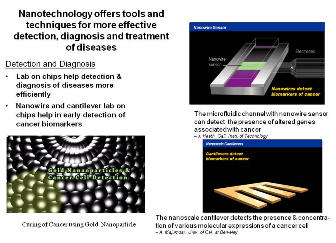 In one recent study, complexing antisense DNA with gold nanoparticles was demonstrated to boost
delivery into cancer cells. In addition, the antisense molecules also bound to their targets more efficiently.
In one recent study, complexing antisense DNA with gold nanoparticles was demonstrated to boost
delivery into cancer cells. In addition, the antisense molecules also bound to their targets more efficiently.
Nanotechnology-based diagnostic and therapeutic tools are also being developed for medical conditions such as cardiac disease and neurological disorders. Because they can cross the blood-brain barrier, nanoparticles hold particular promise for efficient drug delivery systems for brain disorders. In one recent study, an analgesic drug attached to albumin nanoparticles was successfully delivered to the brains of mice.
Nanoparticles find many applications in curing the dreaded diseases. Scientists at MIT have designed a new type of nanoparticle that could deliver vaccines
effectively for diseases like HIV, Malaria.  Synthetic Protein vaccines are covered by fatty droplets called liposomes which increase the T-cell response.
Once absorbed by a cell, these droplets degrade quickly and release vaccine and provoke T cell response. These are at the trial stage and soon this would
be a reality in treating the human beings affected with HIV and Malaria.
Synthetic Protein vaccines are covered by fatty droplets called liposomes which increase the T-cell response.
Once absorbed by a cell, these droplets degrade quickly and release vaccine and provoke T cell response. These are at the trial stage and soon this would
be a reality in treating the human beings affected with HIV and Malaria.
Nano Bio medical sensors will play a major role in early detection of dreaded diseases like AIDS and cancer. Immuno assays can be used for detecting antigens in blood samples by introduction of nanoshells attached to antibodies while sampling blood. Nanomagnetic particles can be used for targeted treatment and diagnosis. Nanosensor based smart drug delivery systems discharge drugs in appropriate quantity and at the right time. Similarly, nanotechnology offers a wide range of opportunities such as synthetic scaffolding and nanoceramic coatings for tissue repair and implants respectively.
CONCLUSION
Technology can effect the most fundamental changes in the ground rules of economic competitiveness and societal prosperity for any country. Technology is Neutral - Neither good nor evil. It is up to us to breathe the moral and ethical life into these technologies and then apply them with compassion towards each and every patient. Healers have always occupied a very special place in society – not only of the wounded body, but also of wounded hearts, minds and souls. The exciting advances in medical science are opening up a world of unimaginable and enormous possibilities for us to defeat the age-old scourge of disease. We continue to witness human sufferings due to the dreaded diseases. You are greatly privileged to be part of a very important section of our society to be able to reduce the pain of the society in curing such complicated diseases. As young medical professionals, you have to use and apply new, powerful and exciting medical technologies in socially responsible ways to bring new cures to those who need them the most at an affordable cost and reduced pain to the patients.
May the blessings of the almighty be with you, in performing and succeeding in your noble task of healing the pain of the people and bring solace and happiness to millions of fellow human beings.
I congratulate you all and wish you all the best in the future.




